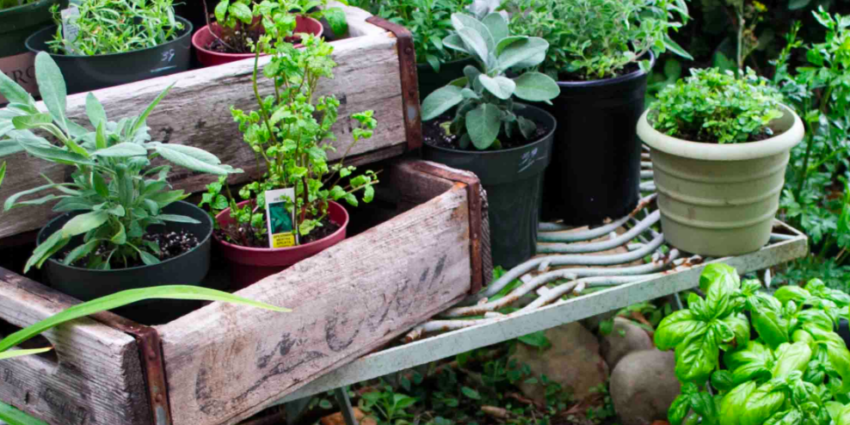By growing your very own fresh herbs, your medicine cabinet is only as far as your garden plot! Here you’ll find five all-star plants that have potent medicinal properties and thus dubbed “healing herbs.”
If you aren’t able to grow them yourself, you can still benefit from their healing nature by looking out for them throughout the summer at your local farmer’s market or roadside farm stand.
As with all herbs, take caution and consult with your doctor if you are pregnant. A very simple way to prepare herbs for daily medicinal use at home is to make an infusion with the fresh or dried plant (see each entry for specifics about whether to use the flower, leaves, or roots). A therapeutic dose of herbal tea is 4 cups daily.
To Make an Infusion:
Ratio: 1 tablespoon of herbs per 1 cup of water
- Heat water to a boil; turn off heat
- Place herbs in a jar, cup, or tea ball
- Pour boiling water over the herbs and let the tea steep for the desired time (20 minutes – 12 hours)
- If not using a tea ball, strain and enjoy!
Lavender (Lavendula officinalis)
Healing properties:
A very effective calming sedative for insomnia and anxiety, Lavender also settles digestion and soothes a nervous stomach. It is commonly drunk as a tea for headaches, migraines, circulatory issues, and arthritis. Topically it is used as an antiseptic to treat wounds, burns, itchy skin conditions, fungal infections, insect stings, and pain.
Growing basics:
- WHERE: pots or garden bed; very sunny window sill or outdoors
- HOW: sow seeds direct or take cuttings from the side shoots of mature plants
- SUN: full sun (needs plenty of sun to thrive)
- SOIL: well-drained
- WATER: moderate
Preparation:
Harvest flowers in mid-summer when petals have just begun to open. To dry them, place them in a basket in a well-ventilated area for a few days. Use the flowers in a tea/ infusion.
Lemon Balm (Melissa officinalis)
Healing properties:
With soothing, calming, yet uplifting properties, Lemon Balm helps with depression as well as focus, and is good for those who struggle with ADD / ADHD. A very safe herb in general, it can be used with children. However, it is contraindicated in cases of hypothyroidism.
Growing basics:
- WHERE: pots or garden bed; window sill or outdoors
- HOW: seedling or root division/cutting
- SUN: full sun or partial shade
- SOIL: fertile, well-drained
- WATER: moderate
Preparation:
Make a tea/infusion of fresh or dried leaves that can be picked throughout the growing season
Peppermint (Mentha piperita)
Healing properties:
Good for all digestive issues! Eases menstrual cramps and tension headaches. Inhale vapors for sinus congestion.
Growing basics:
- WHERE: containers unless you want it to take over your garden; window sill or outdoors
- HOW: seedling or root division/cutting
- SUN: full sun or partial shade
- SOIL: fertile, well-drained
- WATER: ample
Preparation:
Tea/infusion of fresh or dried leaves that can be picked throughout the growing season
Calendula (Calendula officinalis)
Healing properties:
Calendula is traditionally used topically used as an antiseptic and anti-inflammatory. In traditional Chinese medicine, it’s known as a blood mover and is an effective lymph system tonic. Its anti-fungal and anti-septic qualities make it useful for thrush and yeasty conditions. Tea moderates fever. Avoid internal use in pregnancy.
Growing basics:
- WHERE: garden bed
- HOW: seedling or sow seeds direct
- SUN: full sun / partial shade
- SOIL: not picky
- WATER: average requirements
Preparation:
Tea of the flowers (dried or fresh), which can be picked all season long. The more you pick the flowers, the more flowers the plant will produce.
Tulsi/Holy Basil (Ocimum sanctum)
Healing properties:
Because Tulsi has heating and drying properties, it’s a great digestive remedy for damp conditions such as IBS or diarrhea. It supports the respiratory system, and can help with bronchitis, allergies, cough, and asthma. Tulsi lowers blood sugar, lowers fever, and increases our capacity to handle stress. Also, this healing herb supports the heart, and opens the heart chakra. Daily use is said to help you maintain balanced chakras. Tulsi is contraindicated if you typically run very hot or are a Type-A personality (Pitta dosha).
Growing basics:
- WHERE: pots or garden bed; window sill or outdoors
- HOW: seedling or sow seeds direct
- SUN: full sun / warm temps
- SOIL: rich
- WATER: average requirements
Preparation:
In order to prepare, harvest mid-summer when the plant is about a foot tall. Harvest only 50% of the leaves and it will continue to grow, providing you with a second and third harvest. Make a tea of the leaves (dried or fresh).
To learn more about herbal remedies, I recommend reading: Rosemary Gladstar’s Medicinal Herbs: A Beginner’s Guide.

